

高等学校化学学报 ›› 2021, Vol. 42 ›› Issue (2): 380.doi: 10.7503/cjcu20200707
收稿日期:2020-09-23
出版日期:2021-02-10
发布日期:2020-12-28
通讯作者:
陶莹
E-mail:yingtao@tju.edu.cn
基金资助:
DENG Yaqian1, WU Zhitan2, LV Wei1, TAO Ying2( ), YANG Quanhong2
), YANG Quanhong2
Received:2020-09-23
Online:2021-02-10
Published:2020-12-28
Contact:
TAO Ying
E-mail:yingtao@tju.edu.cn
Supported by:摘要:
近年来, 二维材料由于其独特的结构以及高电化学活性在储能领域中备受关注. 然而在实际应用中, 二维材料的“面-面”堆叠极大地限制了其性能的发挥. 凝胶化作为实现纳米材料液相三维组装的重要手段, 不仅可以有效减少二维材料的团聚, 保留更多活性位点, 同时形成的三维网络结构可以提供畅通的离子电子传输通道, 提升材料在储能应用中的实用性. 不仅如此, 二维材料的凝胶化在电极材料孔结构设计以及活性物质缓冲空间定制方面具有先天优势. 本文以氧化石墨烯凝胶化过程的方法和原理为基础, 综合评述了石墨烯及其它几类较典型的二维材料的凝胶化机制及方法, 梳理了其孔结构调控策略, 并对凝胶化二维储能材料的设计以及应用进行了归纳、 总结及展望.
中图分类号:
TrendMD:
邓亚茜, 吴志坦, 吕伟, 陶莹, 杨全红. 二维材料的凝胶化及电化学储能应用. 高等学校化学学报, 2021, 42(2): 380.
DENG Yaqian, WU Zhitan, LV Wei, TAO Ying, YANG Quanhong. Gelation of Two⁃dimensional Materials for Energy Storage Applications. Chem. J. Chinese Universities, 2021, 42(2): 380.
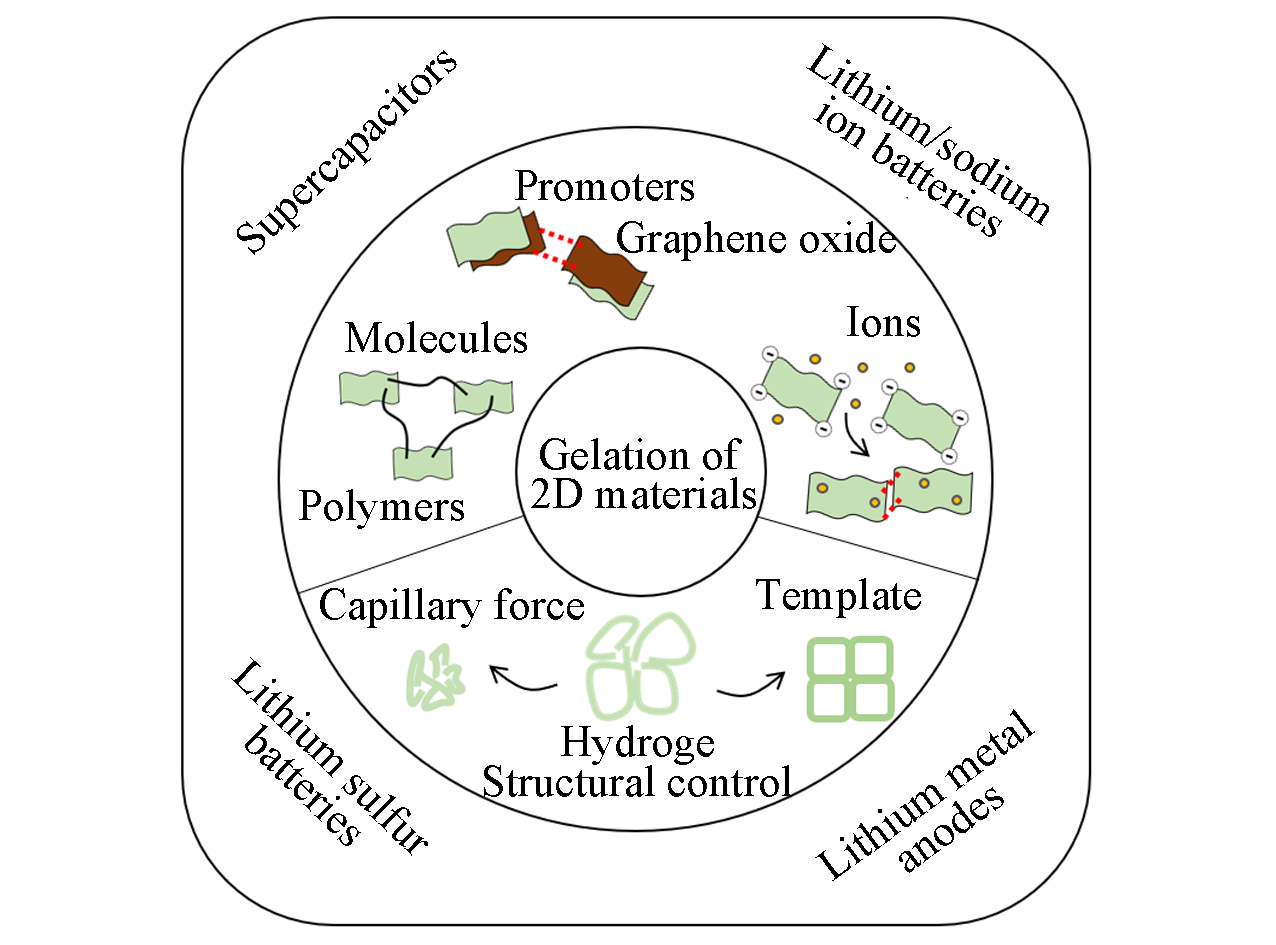
Fig.1 Scheme of the strategies for the gelation of 2D materials along with their applications in supercapacitors, lithium/sodium ion batteries, lithium sulfur batteries and lithium metal anodes
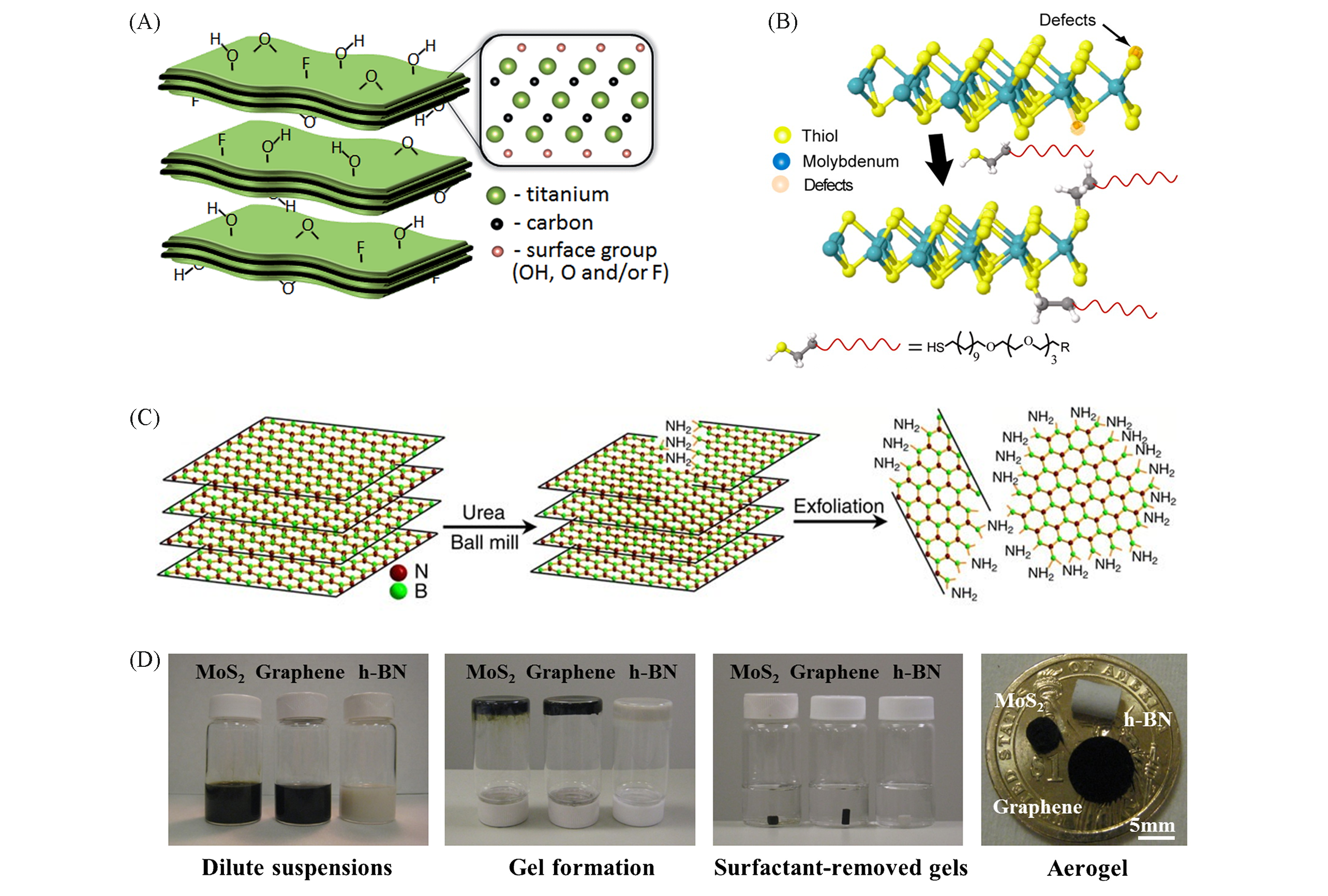
Fig.3 Scheme of two?dimensional(2D) colloidal sheets(A) Schematic of Ti3C2Tx?MXene colloidal sheets[27]. Copyright 2014, Royal Society of Chemistry.(B) Structural models of ligand conjugation MoS2 sheets[31]. Copyright 2013, American Chemical Society.(C) Schematic illustration of the BN colloidal sheets[32]. Copyright 2015, Springer Nature.(D) Photos of suspensions, hydrogels, surfactant?removed gels, and aerogels of graphene, MoS2, and BN sheets[21]. Copyright 2012, Springer Nature.
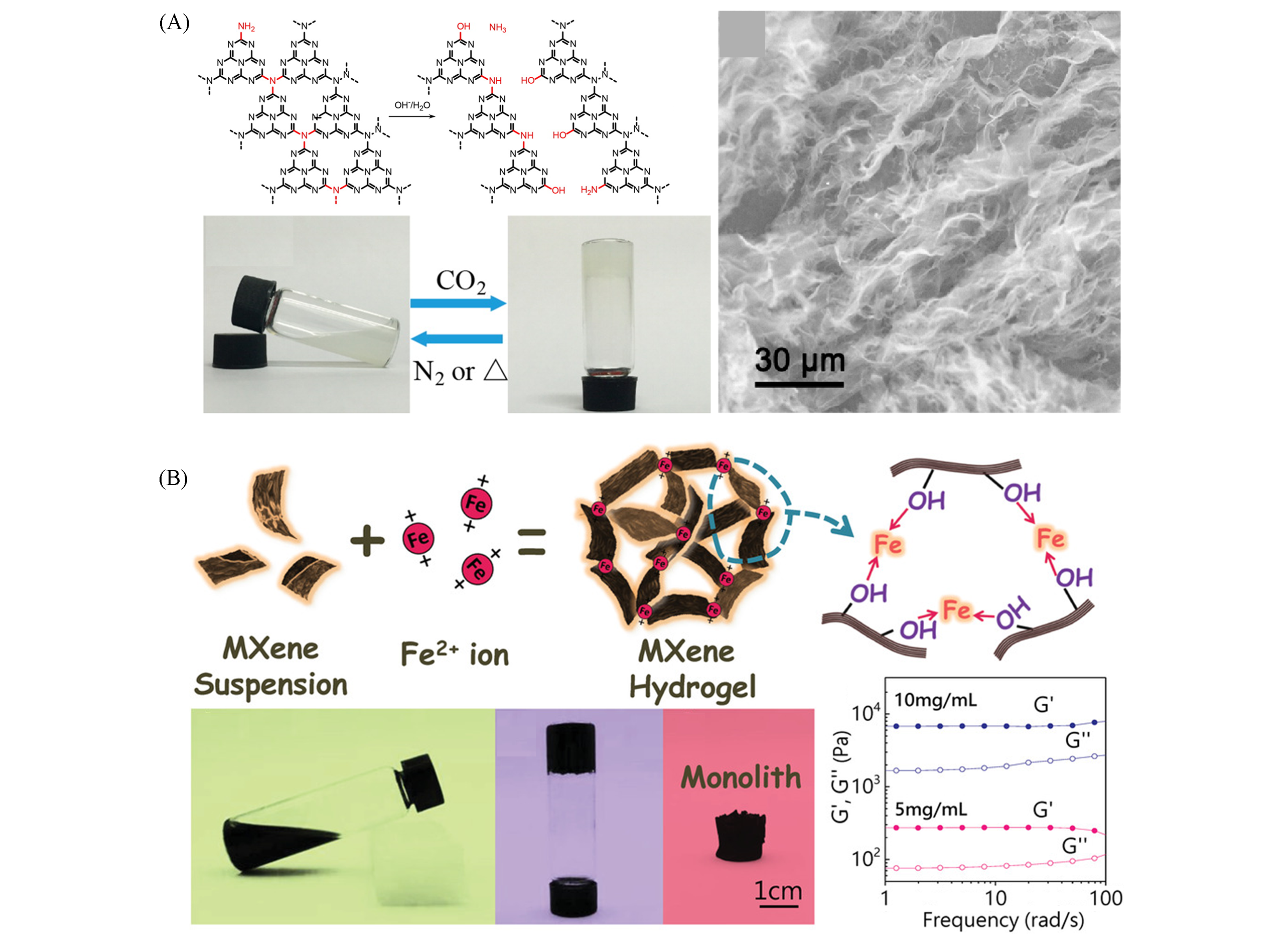
Fig.6 Photographs and scheme of C3N4 hydrogels triggered by CO2(A)[49] and MXene hydrogels mediated by Fe2+ ions(B)[53](A) Copyright 2016, American Chemical Society. (B) Copyright 2019, Wiley?VCH.
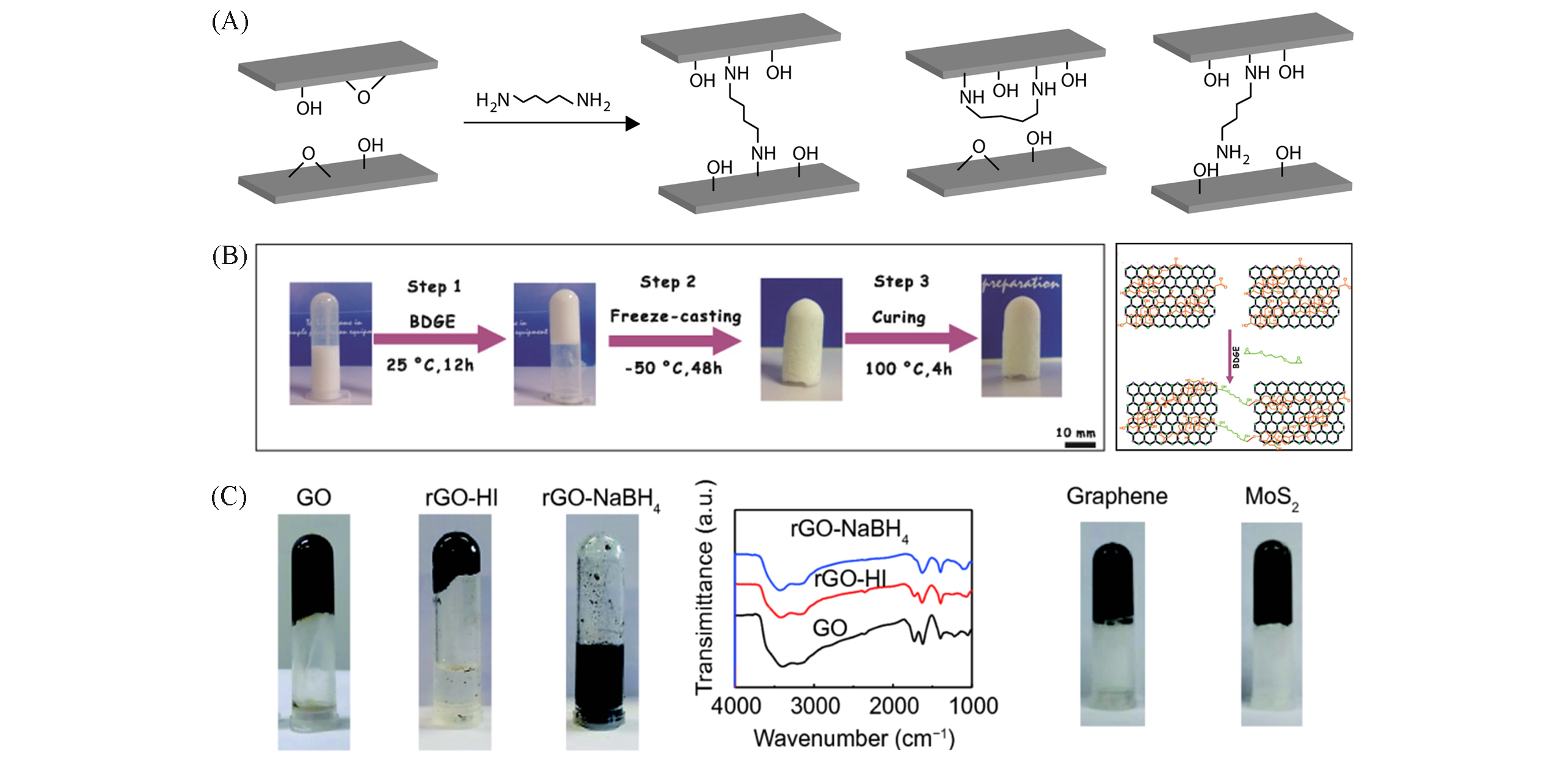
Fig.7 Scheme of the diaminoalkane intercalation reaction in the interlayer of GO[55](A) and photos of h?BN[57](B) and MoS2[58](C) formed with the assistance of cross?linker(A) Copyright 2007, American Chemical Society.(B) Copyright 2015, American Chemical Society. (C) Copyright 2018, Springer Nature.
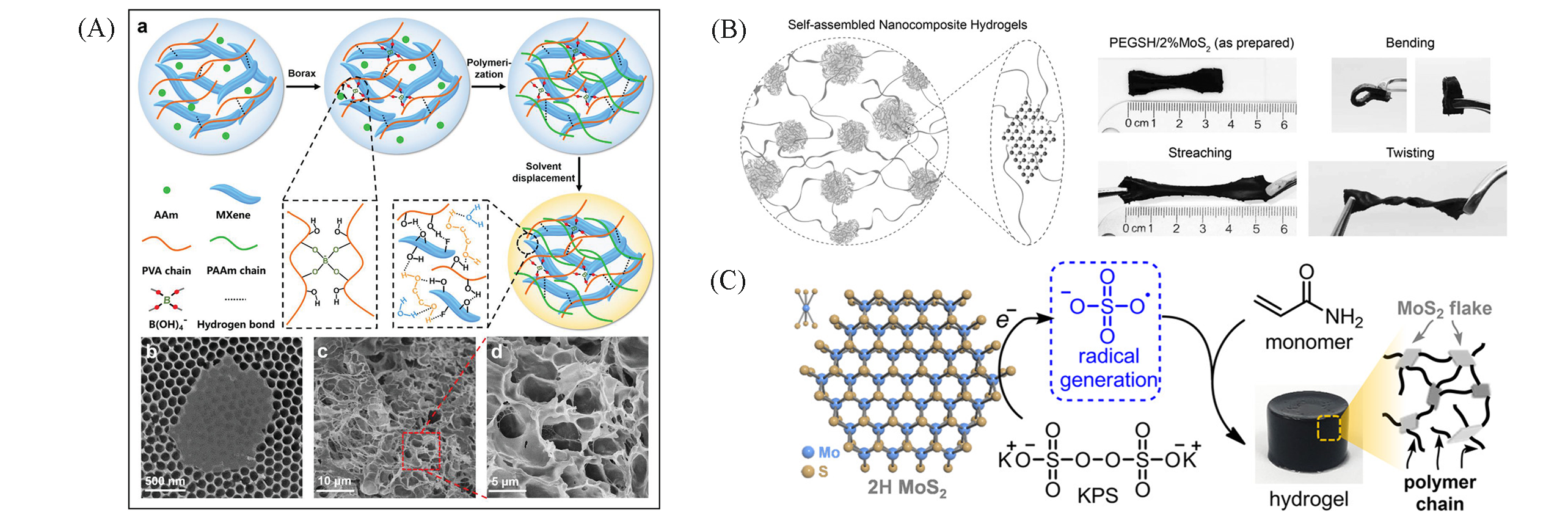
Fig.8 Scheme and photos of MXene?polymer and MoS2?polymer composite hydrogels(A) Schematic illustration of the fabrication self?healing MXene nano composite organohydrogel(MNOH)[63]. Copyright 2019, Wiley?VCH. (B) Schematic illustration of PEG?SH MoS2 composite hydrogels[64]. Copyright 2017, Wiley?VCH. (C) Schematic description of polymerization of acrylamide triggered by MoS2 and potassium persulfate(KPS), and the formation of the MoS2 composite hydrogel[65]. Copyright 2020, American Chemical Society.
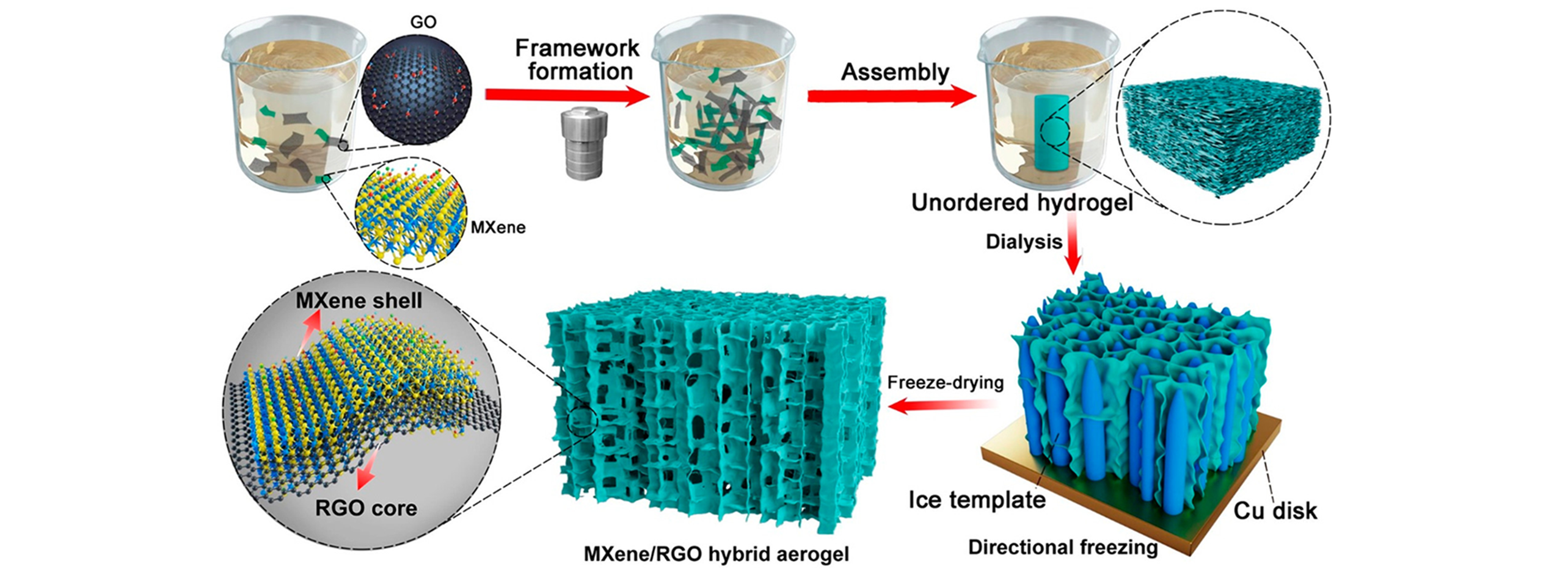
Fig.9 Scheme of the hydrothermal assembly for a MXene/rGO hydrogel, and directional freezing and freeze drying process for the fabrication of MXene/rGO aerogel[46]Copyright 2018, American Chemical Society.
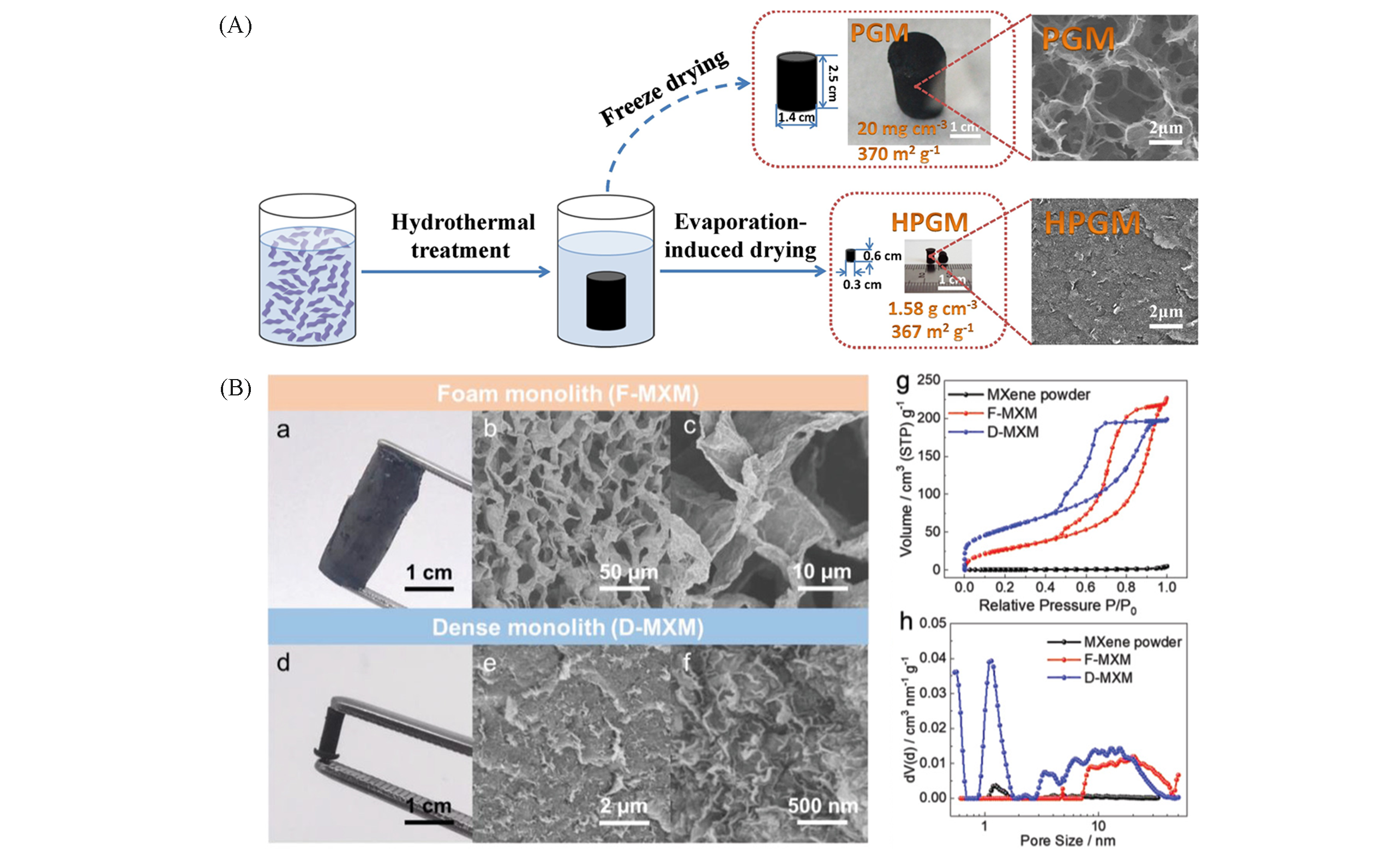
Fig.10 Schematic illustrating of highly dense and porous graphene?based monolithic carbon(HPGM)(A)[77] and dense 3D MXene monolith(D?MXM)(B)[43](A) Copyright 2013, Springer Nature; (B) Copyright 2019, Wiley?VCH.
| Device | Electrode | Material | Capacitance (Capacity) | Rate capability | Cycling capability | Ref. |
|---|---|---|---|---|---|---|
SCa | Work electrode (collected in three? electrode system) | MXene monolith | 272 F?g-1 (2 mV?s-1) | 226 F?g-1 (1000 mV?s-1) | 97.1%(1000 mV?s-1, 10000 cycles) | [ |
| 3D MXH | 370 F?g-1 (5 A?g-1) | 165 F?g-1 (1000 A?g-1) | 98%(1000 mV?s-1, 10000 cycles) | [ | ||
| MXene hydrogel | 1500 F?cm-3 (2 mV?s-1) | 570 F?cm-3 (2000 mV?s-1) | 90%(10 A?g-1, 10000 cycles) | [ | ||
| Printed electrode | MXene?N ink | 70.1 mF?cm-2 (10 mV?s-1) | 62.5 mF?cm-2 (100 mV?s-1) | 92%(5 mA cm-1, 7000 cycles) | [ | |
| SICb | Anode | 3D macroporous MXene film | 330 mA?h?g-1 (0.25C) | 120 mA?h?g-1 (25C) | 53.8%(2.5 C, 1000 cycles) | [ |
| Printed anode | Porous N?Ti3C2Tx ink | 240 mA?h?g-1, (0.5C) | 200 mA?h?g-1 (5C) | 260 mA h g-1(5C, 1000 cycles) | [ | |
| SIBc | Anode | VO2/MXene | 280.9 mA?h?g-1 (0.1 A?g-1) | 206 mA?h?g-1 (1.6 A?g-1) | 141%(0.1 A?g-1, 200 cycles) | [ |
| Ti3C2/NiCoP | 416.9 mA?h?g-1 (0.1 A?g-1) | 240.1 mA?h?g-1 (2 A?g-1) | 261.7 mA?h?g-1 (1 A?g-1, 2000 cycles) | [ | ||
| Na?c?Ti3C2Tx | 148.3 mA?h?g-1 (25 mA?g-1) | 61 mA?h?g-1 (1 A?g-1) | 130.0 mA?h?g-1 (0.1 A?g-1, 500 cycles) | [ | ||
| PANI/Ti3C2Tx | 254 mA?h?g-1 (100 mA?g-1) | 142 mA?h?g-1 (5 A?g-1) | 135.4 mA?h?g-1(2 A?g-1, 10000 cycles) | [ | ||
| LIBd | Anode | 3D porous MXene foam | 455.5 mA?h?g-1 (50 mA?g-1) | 101 mA?h?g-1 (18 A?g-1) | 220 mA?h?g-1(1 A?g-1, 3500 cycles) | [ |
| LSBe | Cathode | a?Ti3C2?S | 539 mA?h?g-1, (0.5C) | 691 mA?h?g-1 (2C) | 50.4%(2C, 500 cycles) | [ |
Crumpled N?Ti3C2Tx/S | 1144 mA?h?g-1 (0.2C) | 770 mA?h?g-1 (2C) | 74%(2C, 1000 cycles) | [ | ||
| S@Ti3C2Tx | 1244 mA?h?g-1 (0.1C) | 1004 mA?h?g-1 (2C) | 61%(0.2C, 800 cycles) | [ |
Table 1 Electrochemical performance of gelated MXenes in supercapacitors and other rechargeable battery applications
| Device | Electrode | Material | Capacitance (Capacity) | Rate capability | Cycling capability | Ref. |
|---|---|---|---|---|---|---|
SCa | Work electrode (collected in three? electrode system) | MXene monolith | 272 F?g-1 (2 mV?s-1) | 226 F?g-1 (1000 mV?s-1) | 97.1%(1000 mV?s-1, 10000 cycles) | [ |
| 3D MXH | 370 F?g-1 (5 A?g-1) | 165 F?g-1 (1000 A?g-1) | 98%(1000 mV?s-1, 10000 cycles) | [ | ||
| MXene hydrogel | 1500 F?cm-3 (2 mV?s-1) | 570 F?cm-3 (2000 mV?s-1) | 90%(10 A?g-1, 10000 cycles) | [ | ||
| Printed electrode | MXene?N ink | 70.1 mF?cm-2 (10 mV?s-1) | 62.5 mF?cm-2 (100 mV?s-1) | 92%(5 mA cm-1, 7000 cycles) | [ | |
| SICb | Anode | 3D macroporous MXene film | 330 mA?h?g-1 (0.25C) | 120 mA?h?g-1 (25C) | 53.8%(2.5 C, 1000 cycles) | [ |
| Printed anode | Porous N?Ti3C2Tx ink | 240 mA?h?g-1, (0.5C) | 200 mA?h?g-1 (5C) | 260 mA h g-1(5C, 1000 cycles) | [ | |
| SIBc | Anode | VO2/MXene | 280.9 mA?h?g-1 (0.1 A?g-1) | 206 mA?h?g-1 (1.6 A?g-1) | 141%(0.1 A?g-1, 200 cycles) | [ |
| Ti3C2/NiCoP | 416.9 mA?h?g-1 (0.1 A?g-1) | 240.1 mA?h?g-1 (2 A?g-1) | 261.7 mA?h?g-1 (1 A?g-1, 2000 cycles) | [ | ||
| Na?c?Ti3C2Tx | 148.3 mA?h?g-1 (25 mA?g-1) | 61 mA?h?g-1 (1 A?g-1) | 130.0 mA?h?g-1 (0.1 A?g-1, 500 cycles) | [ | ||
| PANI/Ti3C2Tx | 254 mA?h?g-1 (100 mA?g-1) | 142 mA?h?g-1 (5 A?g-1) | 135.4 mA?h?g-1(2 A?g-1, 10000 cycles) | [ | ||
| LIBd | Anode | 3D porous MXene foam | 455.5 mA?h?g-1 (50 mA?g-1) | 101 mA?h?g-1 (18 A?g-1) | 220 mA?h?g-1(1 A?g-1, 3500 cycles) | [ |
| LSBe | Cathode | a?Ti3C2?S | 539 mA?h?g-1, (0.5C) | 691 mA?h?g-1 (2C) | 50.4%(2C, 500 cycles) | [ |
Crumpled N?Ti3C2Tx/S | 1144 mA?h?g-1 (0.2C) | 770 mA?h?g-1 (2C) | 74%(2C, 1000 cycles) | [ | ||
| S@Ti3C2Tx | 1244 mA?h?g-1 (0.1C) | 1004 mA?h?g-1 (2C) | 61%(0.2C, 800 cycles) | [ |
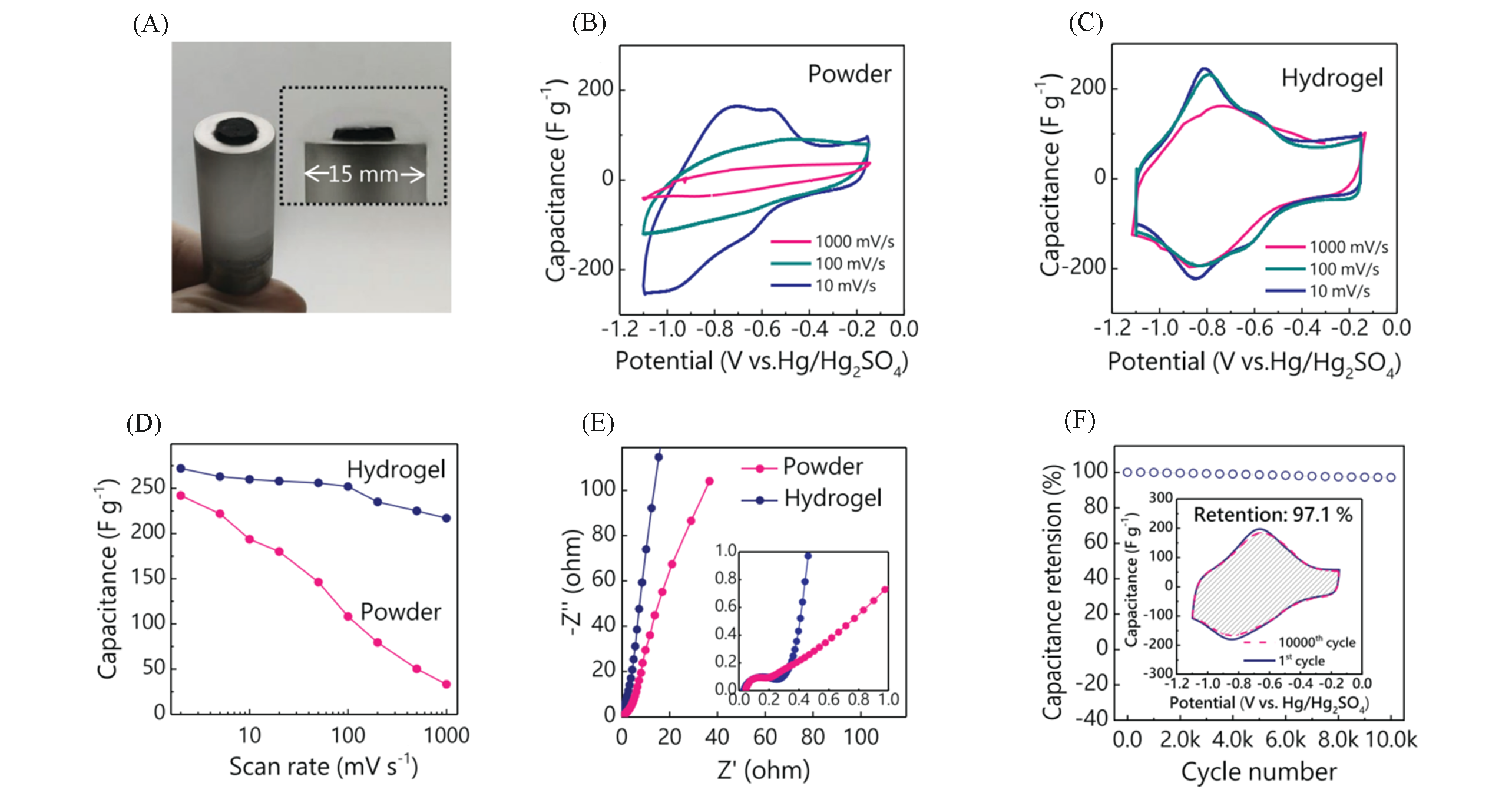
Fig.11 Electrochemical performance of the MXene powder and MXene hydrogel for supercapacitors[53](A) Photo of the MXene hydrogel electrode; (B, C) CV profiles of MXene powder and hydrogel; (D, E) rate performances and electrochemical impedance spectroscopy data of MXene powder and hydrogel; (F) capacitance retention of MXene hydrogel. Inset shows the CV profiles of MXene hydrogel at 1st cycle and 10000th cycle.Copyright 2019, Wiley?VCH.
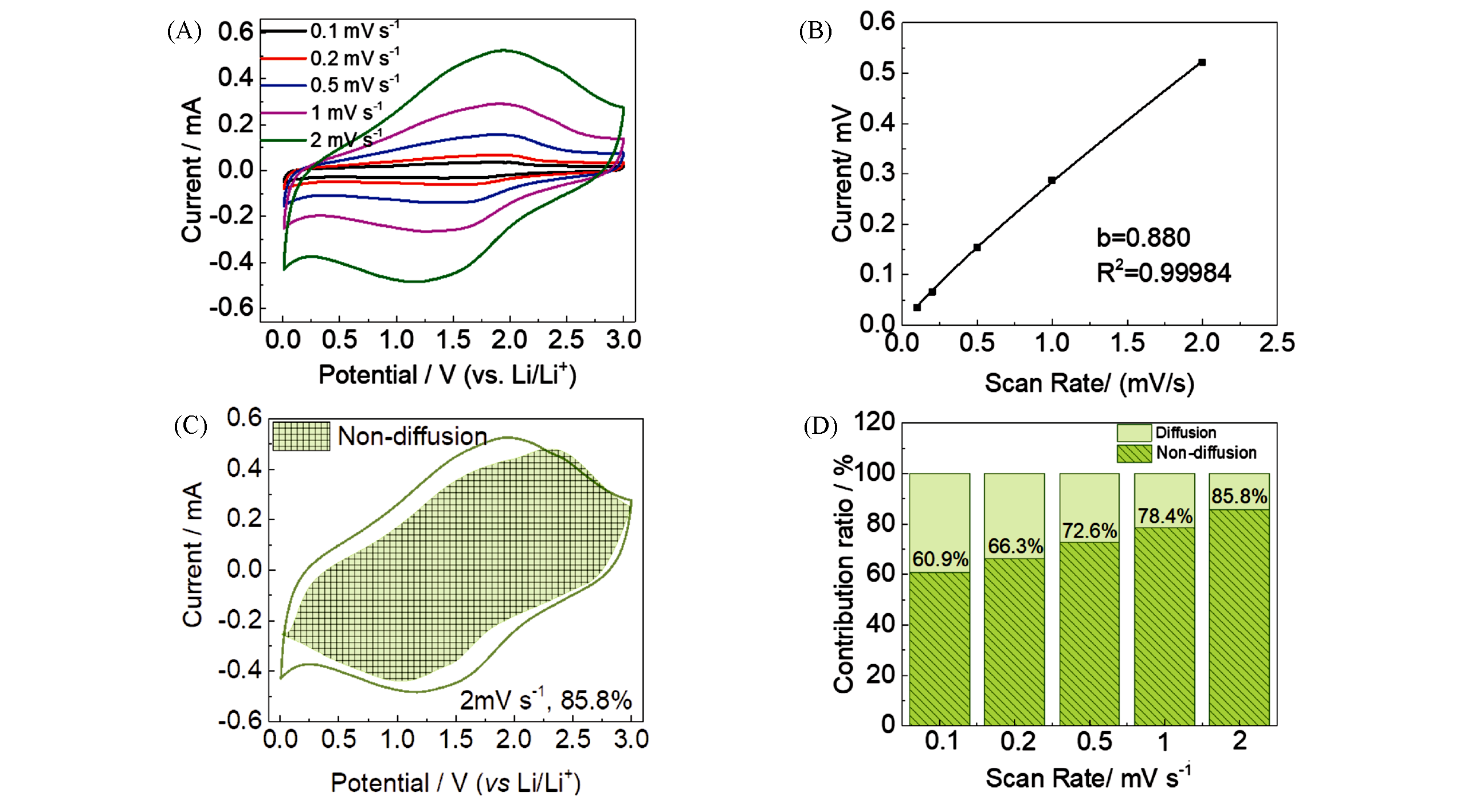
Fig.12 Electrochemical performance and capacitive contribution of porous MXene film at different scan rates[68]CV profiles of the p?MXene?71 electrode; (B) relationship between the peak current and the scan rate at 2.0 V; (C) CV profile at 2 mV/s with shaded part showing the capacitive contribution; (D) capacitive contribution at different scan rates.Copyright 2019, Wiley?VCH.
| 1 | Geim A. K., Novoselov K. S., Nat. Mater., 2007, 6(3), 183—191 |
| 2 | Xu M., Liang T., Shi M., Chen H., Chem. Rev., 2013, 113(5), 3766—3798 |
| 3 | Miro P., Audiffred M., Heine T., Chem. Soc. Rev., 2014, 43(18), 6537—6554 |
| 4 | Liu Z., Lau S. P., Yan F., Chem. Soc. Rev., 2015, 44(15), 5638—5679 |
| 5 | Zhang X., Hou L., Ciesielski A., Samorì P., Adv. Energy Mater., 2016, 1600671 |
| 6 | Luo J., Kim J., Huang J., Acc. Chem. Res., 2013, 46(10), 2225—2234 |
| 7 | Wu Z., Shang T., Deng Y., Tao Y., Yang Q. H., Adv. Sci., 2020, 1903077 |
| 8 | Shehzad K., Xu Y., Gao C., Duan X., Chem. Soc. Rev., 2016, 45(20), 5541—5588 |
| 9 | Liang Q., Li Z., Yu X., Huang Z. H., Kang F., Yang Q. H., Adv. Mater., 2015, 27(31), 4634—4639 |
| 10 | Worsley M. A., Shin S. J., Merrill M. D., Lenhardt J., Nelson A. J., Woo L. Y., Gash A. E., Baumann T. F., Orme C. A., ACS Nano, 2015, 9(5), 4698—4705 |
| 11 | Long H., Chan L., Harley⁃Trochimczyk A., Luna L. E., Tang Z., Shi T., Zettl A., Carraro C., Worsley M. A., Maboudian R., Adv. Mater. Interfaces, 2017, 4(16), 1700217 |
| 12 | Rousseas M., Goldstein A. P., Mickelson W., Worsley M. A., Woo L., Zettl A., ACS Nano, 2013, 7(10), 8540—8546 |
| 13 | Yin J., Li X., Zhou J., Guo W., Nano Lett., 2013, 13(7), 3232—3236 |
| 14 | Lv W., Zhang C., Li Z., Yang Q. H., J. Phys. Chem. Lett., 2015, 6(4), 658—668 |
| 15 | Vogel N., Retsch M., Fustin C. A., Del Campo A., Jonas U., Chem. Rev., 2015, 115(13), 6265—6311 |
| 16 | Feinle A., Elsaesser M. S., Husing N., Chem. Soc. Rev., 2015, 45(12), 3377—3399 |
| 17 | Li C., Shi G., Adv. Mater., 2014, 26(24), 3992—4012 |
| 18 | Luo J., Cote L. J., Tung V. C., Tan A. T., Goins P. E., Wu J., Huang J., J. Am. Chem. Soc., 2010, 132(50), 17667—17669 |
| 19 | Mas⁃Balleste R., Gomez⁃Navarro C., Gomez⁃Herrero J., Zamora F., Nanoscale, 2011, 3(1), 20—30 |
| 20 | Huo C., Yan Z., Song X., Zeng H., Sci. Bull., 2015, 60(23), 1994—2008 |
| 21 | Jung S. M., Jung H. Y., Dresselhaus M. S., Jung Y. J., Kong J., Sci. Rep., 2012, 2, 849 |
| 22 | Kim J., Cote L. J., Kim F., Yuan W., Shull K. R., Huang J., J. Am. Chem. Soc., 2010, 132(23), 8180—8186 |
| 23 | Kim J., Cote L. J., Huang J., Acc. Chem. Res., 2012, 45(8), 1356—1364 |
| 24 | Yu W., Sisi L., Haiyan Y., Jie L., RSC Adv., 2020, 10(26), 15328—15345 |
| 25 | Chen J., Zhang Y., Zhang M., Yao B., Li Y., Huang L., Li C., Shi G., Chem. Sci., 2016, 7(3), 1874—1881 |
| 26 | Ahn H., Kim T., Choi H., Yoon C., Um K., Nam J., Ahn K. H., Lee K., Carbon, 2014, 71, 229—237 |
| 27 | Mashtalir O., Cook K. M., Mochalin V. N., Crowe M., Barsoum M. W., Gogotsi Y., J. Mater. Chem. A, 2014, 2(35), 14334—14338 |
| 28 | Li J., Yuan X., Lin C., Yang Y., Xu L., Du X., Xie J., Lin J., Sun J., Adv. Energy Mater., 2017, 7(15), 1602725 |
| 29 | Coleman J. N., Lotya M., O'Neill A., Bergin S. D., King P. J., Khan U., Young K., Gaucher A., De S., Smith R. J., Shvets I. V., Arora S. K., Stanton G., Kim H. Y., Lee K., Kim G. T., Duesberg G. S., Hallam T., Boland J. J., Wang J. J., Donegan J. F., Grunlan J. C., Moriarty G., Shmeliov A., Nicholls R. J., Perkins J. M., Grieveson E. M., Theuwissen K., McComb D. W., Nellist P. D., Nicolosi V., Science, 2011, 331(6017), 568—571 |
| 30 | Marsh K. L., Souliman M., Kaner R. B., Chem. Commun.(Camb), 2015, 51(1), 187—190 |
| 31 | Chou S. S., De M., Kim J., Byun S., Dykstra C., Yu J., Huang J., Dravid V. P., J. Am. Chem. Soc., 2013, 135(12), 4584—4587 |
| 32 | Lei W., Mochalin V. N., Liu D., Qin S., Gogotsi Y., Chen Y., Nat. Commun., 2015, 6, 8849 |
| 33 | Smith R. J., King P. J., Lotya M., Wirtz C., Khan U., De S., O'Neill A., Duesberg G. S., Grunlan J. C., Moriarty G., Chen J., Wang J., Minett A. I., Nicolosi V., Coleman J. N., Adv. Mater., 2011, 23(34), 3944—3948 |
| 34 | Bari R., Parviz D., Khabaz F., Klaassen C. D., Metzler S. D., Hansen M. J., Khare R., Green M. J., Phys. Chem. Chem. Phys., 2015, 17(14), 9383—9393 |
| 35 | Liu X., Liu J., Lin S., Zhao X., Mater. Today, 2020, 36, 102—124 |
| 36 | Yu Y., Chen H., Liu Y., Craig V. S. J., Wang C., Li L. H., Chen Y., Adv. Mater. Interfaces, 2015, 2(1), 1400267 |
| 37 | Zhang L., Shi G., J. Phys. Chem. C, 2011, 115(34), 17206—17212 |
| 38 | Xu Y., Sheng K., Li C., Shi G., ACS Nano, 2010, 4(7), 4324—4330 |
| 39 | Chen Y., Xie X., Xin X., Tang Z. R., Xu Y. J., ACS Nano, 2018, 13(1), 295—304 |
| 40 | Liu S., Shi X., Li X., Sun Y., Zhu J., Pei Q., Liang J., Chen Y., Nanoscale, 2018, 10(43), 20096—20107 |
| 41 | An F., Li X., Min P., Li H., Dai Z., Yu Z. Z., Carbon, 2018, 126, 119—127 |
| 42 | Gong Y., Yang S., Zhan L., Ma L., Vajtai R., Ajayan P. M., Adv. Funct. Mater., 2014, 24(1), 125—130 |
| 43 | Shang T., Lin Z., Qi C., Liu X., Li P., Tao Y., Wu Z., Li D., Simon P., Yang Q. H., Adv. Funct. Mater., 2019, 29(33), 1903960 |
| 44 | Ma Z., Zhou X., Deng W., Lei D., Liu Z., ACS Appl. Mater. Interfaces, 2018, 10(4), 3634—3643 |
| 45 | Yue Y., Liu N., Ma Y., Wang S., Liu W., Luo C., Zhang H., Cheng F., Rao J., Hu X., Su J., Gao Y., ACS Nano, 2018, 12(5), 4224—4232 |
| 46 | Zhao S., Zhang H. B., Luo J. Q., Wang Q. W., Xu B., Hong S., Yu Z. Z., ACS Nano, 2018, 12(11), 11193—11202 |
| 47 | Bai H., Li C., Wang X., Shi G., J. Phys. Chem. C, 2011, 115(13), 5545—5551 |
| 48 | Natu V., Clites M., Pomerantseva E., Barsoum M. W., Mater. Res. Lett., 2018, 6(4), 230—235 |
| 49 | Zhang Y., Zhou Z., Shen Y., Zhou Q., Wang J., Liu A., Liu S., Zhang Y., ACS Nano, 2016, 10(9), 9036—9043 |
| 50 | Cong H. P., Ren X. C., Wang P., Yu S. H., ACS Nano, 2012, 6(3), 2693—2703 |
| 51 | Shao J. J., Wu S. D., Zhang S. B., Lv W., Su F. Y., Yang Q. H., Chem. Commun.(Camb), 2011, 47(20), 5771—5773 |
| 52 | Yeh C. N., Raidongia K., Shao J., Yang Q. H., Huang J., Nat. Chem., 2014, 7(2), 166—170 |
| 53 | Deng Y., Shang T., Wu Z., Tao Y., Luo C., Liang J., Han D., Lyu R., Qi C., Lv W., Kang F., Yang Q. H., Adv. Mater., 2019, 31(43), 1902432 |
| 54 | Wan W., Li L., Zhao Z., Hu H., Hao X., Winkler D. A., Xi L., Hughes T. C., Qiu J., Adv. Funct. Mater., 2014, 24(31), 4915—4921 |
| 55 | Herrera⁃Alonso M., Abdala A. A., McAllister M. J., Aksay I. A., Prud'homme R. K., Langmuir, 2007, 23(21), 10644—10649 |
| 56 | Li L., Zhang M., Zhang X., Zhang Z., J. Power Sources, 2017, 364, 234—241 |
| 57 | Zeng X., Ye L., Yu S., Sun R., Xu J., Wong C. P., Chem. Mater., 2015, 27(17), 5849—5855 |
| 58 | Deng Y., Luo C., Zhang J., Qiu D., Cao T., Lin Q., Lv W., Kang F., Yang Q. H., Sci. China Mater., 2018, 62(5), 745—750 |
| 59 | Liu J., Zhang H. B., Xie X., Yang R., Liu Z., Liu Y., Yu Z. Z., Small, 2018, 14(45), 1802479 |
| 60 | Owuor P. S., Park O. K., Woellner C. F., Jalilov A. S., Susarla S., Joyner J., Ozden S., Duy L., Villegas Salvatierra R., Vajtai R., Tour J. M., Lou J., Galvao D. S., Tiwary C. S., Ajayan P. M., ACS Nano, 2017, 11(9), 8944—8952 |
| 61 | Xing C., Chen S., Liang X., Liu Q., Qu M., Zou Q., Li J., Tan H., Liu L., Fan D., Zhang H., ACS Appl. Mater. Interfaces, 2018, 10(33), 27631—27643 |
| 62 | Xu H., Yin X., Li X., Li M., Liang S., Zhang L., Cheng L., ACS Appl. Mater. Interfaces, 2019, 11(10), 10198—10207 |
| 63 | Liao H., Guo X., Wan P., Yu G., Adv. Funct. Mater., 2019, 29(39), 1904507 |
| 64 | Jaiswal M. K., Carrow J. K., Gentry J. L., Gupta J., Altangerel N., Scully M., Gaharwar A. K., Adv. Mater., 2017, 29(36), 1702037 |
| 65 | Lee K. M., Oh Y., Yoon H., Chang M., Kim H., ACS Appl. Mater. Interfaces, 2020, 12(7), 8642—8649 |
| 66 | Zhao M. Q., Xie X., Ren C. E., Makaryan T., Anasori B., Wang G., Gogotsi Y., Adv. Mater., 2017, 29(37), 1702410 |
| 67 | Choi S. H., Ko Y. N., Lee J. K., Kang Y. C., Adv. Funct. Mater., 2015, 25(12), 1780—1788 |
| 68 | Zhao Q., Zhu Q., Miao J., Zhang P., Wan P., He L., Xu B., Small, 2019, 15(51), 1904293 |
| 69 | Lin Y., Liu F., Casano G., Bhavsar R., Kinloch I. A., Derby B., Adv. Mater., 2016, 28(36), 7993—8000 |
| 70 | Shao Y., El⁃Kady M. F., Lin C. W., Zhu G., Marsh K. L., Hwang J. Y., Zhang Q., Li Y., Wang H., Kaner R. B., Adv. Mater., 2016, 28(31), 6719—6726 |
| 71 | Zeng X., Yao Y., Gong Z., Wang F., Sun R., Xu J., Wong C. P., Small, 2015, 11(46), 6205—6213 |
| 72 | Sambyal P., Iqbal A., Hong J., Kim H., Kim M. K., Hong S. M., Han M., Gogotsi Y., Koo C. M., ACS Appl. Mater. Interfaces, 2019, 11(41), 38046—38054 |
| 73 | Han J., Du G., Gao W., Bai H., Adv. Funct. Mater., 2019, 29(13), 1900412 |
| 74 | Pan Z. Z., Nishihara H., Iwamura S., Sekiguchi T., Sato A., Isogai A., Kang F., Kyotani T., Yang Q. H., ACS Nano, 2016, 10(12), 10689—10697 |
| 75 | Shah S. A., Habib T., Gao H., Gao P., Sun W., Green M. J., Radovic M., Chem. Commun.(Camb), 2016, 53(2), 400—403 |
| 76 | Xiu L., Wang Z., Yu M., Wu X., Qiu J., ACS Nano, 2018, 12(8), 8017—8028 |
| 77 | Tao Y., Xie X., Lv W., Tang D. M., Kong D., Huang Z., Nishihara H., Ishii T., Li B., Golberg D., Kang F., Kyotani T., Yang Q. H., Sci. Rep., 2013, 3, 2975 |
| 78 | Qi C., Luo C., Tao Y., Lv W., Zhang C., Deng Y., Li H., Han J., Ling G., Yang Q. H., Sci. China Mater., 2019, 63(10), 1870—1877 |
| 79 | Lukatskaya M. R., Kota S., Lin Z., Zhao M. Q., Shpigel N., Levi M. D., Halim J., Taberna P. L., Barsoum M. W., Simon P., Gogotsi Y., Nat. Energy, 2017, 2(8), 17105 |
| 80 | Yu L., Fan Z., Shao Y., Tian Z., Sun J., Liu Z., Adv. Energy Mater., 2019, 9(34), 1901839 |
| 81 | Fan Z., Wei C., Yu L., Xia Z., Cai J., Tian Z., Zou G., Dou S. X., Sun J., ACS Nano, 2020, 14(1), 867—876 |
| 82 | Wu F., Jiang Y., Ye Z., Huang Y., Wang Z., Li S., Mei Y., Xie M., Li L., Chen R., J. Mater. Chem. A, 2019, 7(3), 1315—1322 |
| 83 | Zhao D., Zhao R., Dong S., Miao X., Zhang Z., Wang C., Yin L., Energy. Environ. Sci., 2019, 12(8), 2422—2432 |
| 84 | Zhao D., Clites M., Ying G., Kota S., Wang J., Natu V., Wang X., Pomerantseva E., Cao M., Barsoum M. W., Chem. Commun.(Camb), 2018, 54(36), 4533—4536 |
| 85 | Wang X., Wang J., Qin J., Xie X., Yang R., Cao M., ACS Appl. Mater. Interfaces, 2020, 12(35), 39181—39194 |
| 86 | Dong Y., Zheng S., Qin J., Zhao X., Shi H., Wang X., Chen J., Wu Z. S., ACS Nano, 2018, 12(3), 2381—2388 |
| 87 | Bao W., Liu L., Wang C., Choi S., Wang D., Wang G., Adv. Energy Mater., 2018, 8(13), 1702485 |
| 88 | Tang H., Li W., Pan L., Cullen C. P., Liu Y., Pakdel A., Long D., Yang J., McEvoy N., Duesberg G. S., Nicolosi V., Zhang C. J., Adv. Sci., 2018, 5(9), 1800502 |
| 89 | Wang G., Zhang L., Zhang J., Chem. Soc. Rev., 2012, 41(2), 797—828 |
| 90 | Song J., Guo X., Zhang J., Chen Y., Zhang C., Luo L., Wang F., Wang G., J. Mater. Chem. A, 2019, 7(11), 6507—6513 |
| 91 | Zhang X., Lv R., Wang A., Guo W., Liu X., Luo J., Angew. Chem. Int. Ed., 2018, 57(46), 15028—15033 |
| 92 | Yang X., Cheng C., Wang Y., Qiu L., Li D., Science, 2013, 341(6145), 534—537 |
| 93 | Chmiola J., Science, 2006, 313(5794), 1760—1763 |
| 94 | Xu Y., Tao Y., Zheng X., Ma H., Luo J., Kang F., Yang Q. H., Adv. Mater., 2015, 27(48), 8082—8087 |
| 95 | Han J., Kong D., Lv W., Tang D. M., Han D., Zhang C., Liu D., Xiao Z., Zhang X., Xiao J., He X., Hsia F. C., Zhang C., Tao Y., Golberg D., Kang F., Zhi L., Yang Q. H., Nat. Commun., 2018, 9(1), 402 |
| 96 | Li H., Tao Y., Zheng X., Luo J., Kang F., Cheng H. M., Yang Q. H., Energy. Environ. Sci., 2016, 9(10), 3135—3142 |
| 97 | Yang W., Yang J., Byun J. J., Moissinac F. P., Xu J., Haigh S. J., Domingos M., Bissett M. A., Dryfe R. A. W., Barg S., Adv. Mater., 2019, 31(37), 1902725 |
| 98 | Wang X., Mathis T. S., Li K., Lin Z., Vlcek L., Torita T., Osti N. C., Hatter C., Urbankowski P., Sarycheva A., Tyagi M., Mamontov E., Simon P., Gogotsi Y., Nat. Energy, 2019, 4(3), 241—248 |
| [1] | 张义超, 赵付来, 王宇, 王亚玲, 沈永涛, 冯奕钰, 封伟. 基于多层二硒化钨的高性能场效应晶体管的实验优化和理论模拟[J]. 高等学校化学学报, 2022, 43(6): 20220113. |
| [2] | 黄益, 吕玲玲, 潘小鹏, 孙广东, 李永强, 姚菊明, 邵建中. 光交联自支撑丝素蛋白水凝胶的三维快速成型[J]. 高等学校化学学报, 2022, 43(4): 20210841. |
| [3] | 姜雷, 严圣迪, 林宇, 吴国章. 聚碳酸酯熔体在氮气环境中的增黏效应及其机理研究[J]. 高等学校化学学报, 2021, 42(3): 884. |
| [4] | 辛伟闻, 闻利平. 二维材料用于渗透能转换的研究进展[J]. 高等学校化学学报, 2021, 42(2): 445. |
| [5] | 史江维, 孟楠楠, 郭亚梅, 于一夫, 张兵 . 二维材料用于电催化析氢的研究进展[J]. 高等学校化学学报, 2021, 42(2): 492. |
| [6] | 董其政, 翟锦. 基于二维材料的仿生纳流体通道在能量转化中的应用[J]. 高等学校化学学报, 2021, 42(2): 432. |
| [7] | 陈明华, 李宏武, 范鹤, 李誉, 刘威铎, 夏新辉, 陈庆国. 二维过渡金属硫族化合物在超级电容器中的研究进展[J]. 高等学校化学学报, 2021, 42(2): 539. |
| [8] | 王伟, 卢香超, 周立军, 鲁艺珍, 曹阳. 基于二维压电材料功能性器件的设计、 构筑与性能研究[J]. 高等学校化学学报, 2021, 42(2): 595. |
| [9] | 林生晃, 傅年庆, 鲍桥梁. 单元素二维材料及其衍生物作为电荷传输层在太阳能电池中应用的研究进展[J]. 高等学校化学学报, 2021, 42(2): 412. |
| [10] | 陈晓煜, 于然波. 纳米二硫化钼的掺杂及催化电解水产氢的研究进展[J]. 高等学校化学学报, 2021, 42(2): 475. |
| [11] | 余强敏, 张致远, 罗雨婷, 李洋, 成会明, 刘碧录. 金属性二维过渡金属硫化物的溶剂热合成及电催化析氢性能[J]. 高等学校化学学报, 2021, 42(2): 654. |
| [12] | 解忱, 陈娜, 杨雁冰, 袁荃. 核酸适体功能化的二维材料场效应晶体管传感器研究进展[J]. 高等学校化学学报, 2021, 42(11): 3406. |
| [13] | 张鑫, 赵付来, 王宇, 梁雪静, 冯奕钰, 封伟. 碲化锗场效应晶体管的制备及电学性能[J]. 高等学校化学学报, 2020, 41(9): 2032. |
| [14] | 黄文娟, 候华毅, 陈相柏, 翟天佑. 化学气相沉积法制备InSe纳米片及其近红外光探测性能[J]. 高等学校化学学报, 2020, 41(4): 682. |
| [15] | 洪晓钟, 顾芳, 李江涛, 王海军. Patchy粒子聚集的统计力学研究[J]. 高等学校化学学报, 2014, 35(7): 1579. |
| 阅读次数 | ||||||
|
全文 |
|
|||||
|
摘要 |
|
|||||